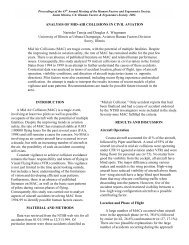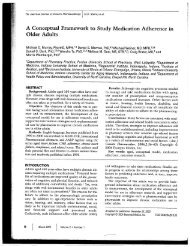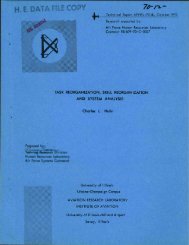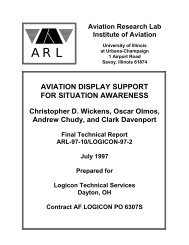Usability Questionnaire Results - Institute of Aviation - University of ...
Usability Questionnaire Results - Institute of Aviation - University of ...
Usability Questionnaire Results - Institute of Aviation - University of ...
You also want an ePaper? Increase the reach of your titles
YUMPU automatically turns print PDFs into web optimized ePapers that Google loves.
Voltage violations were acknowledged by clicking directly on the red voltage value <strong>of</strong>the bus until all voltage violation values turned green. To solve the voltage violations, capacitorscould be opened or closed by clicking directly on a capacitor circuit breaker. The capacitorcircuit breaker was a small square button located on the line nearest the capacitor that it mostdirectly affected. The square button was green when the capacitor was open and red when thecapacitor was closed.3.4.3 Integrated One-Line Display with ContoursThis display was similar to the integrated one-line display; however, it also had contourssuperimposed on the one-line diagram. Specifically, when a voltage limit violation occurred, theregion surrounding the bus experiencing the low voltage became shaded using a contour patternthat varied from dark blue to light blue to yellow in a discrete manner (see Figure 1-2 in theIntroduction). The size and the color <strong>of</strong> the contour was depicted according to the severity <strong>of</strong> thevoltage and its impact on nearby buses. The color key for the meaning <strong>of</strong> the color and contourswas shown on the bottom left-hand side <strong>of</strong> the display. Acknowledging and solving voltageviolations was identical to the procedure for the integrated one-line diagram condition.3.5 NASA-TLXFollowing the experiment, participants were given the NASA-TLX workload assessmentto evaluate the workload associated with the three displays. The NASA-TLX workloadassessment test generates workload value between 0 and 100 for six dimensions <strong>of</strong>ten associatedwith workload. The six dimensions are mental demand, physical demand, temporal demand,performance, effort, and frustration level. A rating sheet is provided that lists the six dimensionswith a Likert scale next to each <strong>of</strong> them. Participants rate the individual dimensions by circlingone <strong>of</strong> the 21 tick marks along the Likert scale. Each tick mark represents a multiple <strong>of</strong> 5starting from 0 to 100, where 0 is a low rating and 100 is a high rating for each dimension.3.6 Procedure3.6.1 Group Assignment and InstructionsParticipants began the experiment by completing the consent form and providing basicdemographic and educational information. They were then randomly assigned to a displaycondition. The three conditions were the separate one-line and tabular display condition (Tabulargroup, n = 9), the integrated one-line condition (One-line group, n = 10), or the integrated onelinewith contours condition (Contour group, n = 9). Participants in each group were thenprovided with specific instructions about the display and tasks that they were to complete as part<strong>of</strong> the experiment. Participants were asked to read through the entire instructions and inform theexperimenter when they were ready to proceed or ask questions if any came up. Theexperimenter reinforced the written instructions by verbally reviewing the main points <strong>of</strong> theinstructions. Points <strong>of</strong> emphasis included reminding the participants that voltage violations werebest solved by clicking on the capacitor that is electrically closest, and that each trial could besolved by closing one capacitor although two or more could be used. In addition they wereasked to be as quick and as accurate as possible when doing the tasks.23















